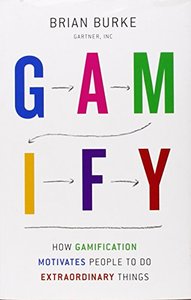GamifyHow Gamification Motivates People to Do Extraordinary Things
|

|
 Diese Seite wurde seit 1 Jahr inhaltlich nicht mehr aktualisiert.
Unter Umständen ist sie nicht mehr aktuell.
Diese Seite wurde seit 1 Jahr inhaltlich nicht mehr aktualisiert.
Unter Umständen ist sie nicht mehr aktuell.
 Zusammenfassungen
Zusammenfassungen
 Organizations are facing an engagement crisis. Regardless if they are customers, employees, patients, students, citizens, stakeholders, organizations struggle to meaningfully engage their key constituent groups who have a precious and limited resource: their time. Not surprisingly, these stakeholders have developed deflector shields to protect themselves. Only a privileged few organizations are allowed to penetrate the shield, and even less will meaningfully engage. To penetrate the shield, and engage the audience, organizations need an edge.
Organizations are facing an engagement crisis. Regardless if they are customers, employees, patients, students, citizens, stakeholders, organizations struggle to meaningfully engage their key constituent groups who have a precious and limited resource: their time. Not surprisingly, these stakeholders have developed deflector shields to protect themselves. Only a privileged few organizations are allowed to penetrate the shield, and even less will meaningfully engage. To penetrate the shield, and engage the audience, organizations need an edge.
Gamification has emerged as a way to gain that edge and organizations are beginning to see it as a key tool in their digital engagement strategy. While gamification has tremendous potential to break through, most companies will get it wrong. Gartner predicts that by 2014, 80% of current gamified applications will fail to meet business objectives primarily due to poor design. As a trend, gamification is at the peak of the hype cycle; it has been oversold and it is broadly misunderstood. We are heading for the inevitable fall. Too many organizations have been led to believe that gamification is a magic elixir for indoctrinating the masses and manipulating them to do their bidding. These organizations are mistaking people for puppets, and these transparently cynical efforts are doomed to fail.
This book goes beyond the hype and focuses on the 20% that are getting it right. We have spoken to hundreds of leaders in organizations around the world about their gamification strategies and we have seen some spectacular successes. The book examines some of these successes and identifies the common characteristics of these initiatives to define the solution space for success. It is a guide written for leaders of gamification initiatives to help them avoid the pitfalls and employ the best practices, to ensure they join the 20% that gets it right.
Gamify shows gamification in action: as a powerful approach to engaging and motivating people to achieving their goals, while at the same time achieving organizational objectives. It can be used to motivate people to change behaviors, develop skills, and drive innovation. The sweet spot for gamification objectives is the space where the business objectives and player objectives are aligned. Like two sides of the same coin, player and business goals may outwardly appear different, but they are often the same thing, expressed different ways. The key to gamification success is to engage people on an emotional level and motivating them to achieve their goals.
 Dieses Buch erwähnt ...
Dieses Buch erwähnt ...
 Begriffe KB IB clear |  Choice Architecture
, Choice Architecture
,  design thinking
, design thinking
,  Digitalisierung
, GamificationGamification
, Digitalisierung
, GamificationGamification
,  Hype Cycle Hype Cycle Hype Cycle
, Hype Cycle
,  Innovation Innovation innovation
, innovation
,  Schneeballsystem Schneeballsystem Ponzi scheme Ponzi scheme
|
 Zitationsgraph
Zitationsgraph
 Zitationsgraph (Beta-Test mit vis.js)
Zitationsgraph (Beta-Test mit vis.js)
 2 Erwähnungen
2 Erwähnungen 
- Wie verändert die Digitalisierung unser Denken und unseren Umgang mit der Welt? (Dirk Baecker) (2016)


- Computerunterstützte Gamifizierung in der Sekundarstufe I - Konzeption und Erforschung von Maßnahmen zur Einbindung spielerischer Elemente in Lernsettings (Nando Stöcklin) (2018)


 Volltext dieses Dokuments
Volltext dieses Dokuments
 Anderswo suchen
Anderswo suchen 
 Beat und dieses Buch
Beat und dieses Buch
Beat hat dieses Buch während seiner Zeit am Institut für Medien und Schule (IMS) ins Biblionetz aufgenommen. Beat besitzt kein physisches, aber ein digitales Exemplar. (das er aber aus Urheberrechtsgründen nicht einfach weitergeben darf). Aufgrund der wenigen Einträge im Biblionetz scheint er es nicht wirklich gelesen zu haben. Es gibt bisher auch nur wenige Objekte im Biblionetz, die dieses Werk zitieren.










 Biblionetz-History
Biblionetz-History